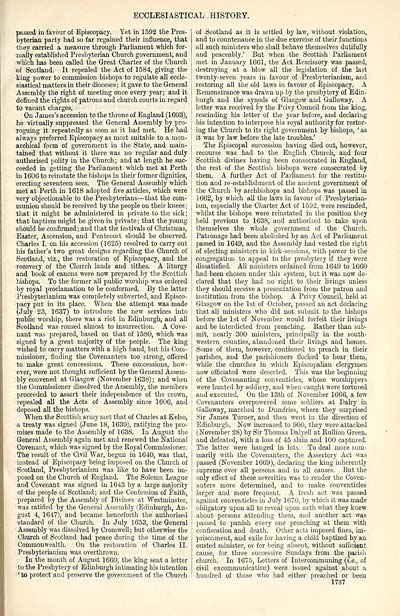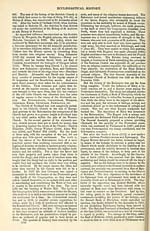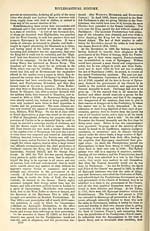Ordnance gazetteer of Scotland
(1745) Page 1737
Download files
Complete book:
Individual page:
Thumbnail gallery: Grid view | List view

ECCLESIASTICAL HISTOEY.
passed in favour of Episcopacy. Yet in 1592 the Pres-
byterian party had so far regained their influence, that
they carried a measure through Parliament which for-
mally established Presbyterian Church government, and
which has been called the Great Charter of the Church
of Scotland. It repealed the Act of 1584, giving the
king power to commission bishops to regulate all eccle-
siastical matters in their dioceses; it gave to the General
Assembly the right of meeting once every year; and it
defined the rights of patrons and church courts in regard
to vacant charges.
On James's accession to the throne of England (1603),
he virtually suppressed the General Assembly by pro-
roguing it repeatedly as soon as it had met. He had
always preferred Episcopacy as most suitable to a mon-
archical form of government in the State, and main-
tained that without it there was no regular and duly
authorised polity in the Church ; and at length he suc-
ceeded in getting the Parliament which met at Perth
in 1606 to reinstate the bishops in their former dignities,
erecting seventeen sees. The General Assembly which
met at Perth in 1618 adopted five articles, which were
very objectionable to the Presbyterians — that the com-
munion should be received by the people on their knees;
that it might be administered in private to the sick;
that baptism might be given in private; that the young
should be confirmed; and that the festivals of Christmas,
Easter, Ascension, and Pentecost should be observed.
Charles I. on his accession (1625) resolved to carry out
his father's two great designs regarding the Church of
Scotland, viz., the restoration of Episcopacy, and the
recovery of the Church lands and tithes. A liturgy
and book of canons were now prepared by the Scottish
bishops. To the former all public worship was ordered
by royal proclamation to be conformed. By the latter
Presbyterianism was completely subverted, and Episco-
pacy put in its place. When the attempt was made
(July 23, 1637) to introduce the new services into
public worship, there was a riot in Edinburgh, and all
Scotland was roused almost to insurrection. A Cove-
nant was prepared, based on that of 1580, which was
signed by a great majority of the people. The king
wished to carry matters with a high hand, but his Com-
missioner, finding the Covenanters too strong, offered
to make great concessions. These concessions, how-
ever, were not thought sufficient by the General Assem-
bly convened at Glasgow (November 1638); and when
the Commissioner dissolved the Assembly, the members
proceeded to assert their independence of the crown,
repealed all the Acts of Assembly since 1606, and
deposed all the bishops.
When the Scottish army met that of Charles at Kelso,
a treaty was signed (June 18, 1639), ratifying the pro-
mises made to the Assembly of 1638. In August the
General Assembly again met and renewed the National
Covenant, which was signed by the Royal Commissioner.
The result of the Civil War, begun in 1640, was that,
instead of Episcopacy being imposed on the Church of
Scotland, Presbyterianism was like to have been im-
posed on the Church of England. The Solemn League
and Covenant was signed in 1643 by a large majority
of the people of Scotland; and the Confession of Faith,
prepared by the Assembly of Divines at Westminster,
was ratified by the General Assembly (Edinburgh, Au-
gust 4, 1647), and became henceforth the authorised
standard of the Church. In July 1653, the General
Assembly was dissolved by Cromwell; but otherwise the
Church of Scotland had peace during the time of the
Commonwealth. On the restoration of Charles II.
Presbyterianism was overthrown.
In the month of August 1660, the king sent a letter
to the Presbytery of Edinburgh intimating his intention
' to protect and preserve the government of the Church
of Scotland as it is settled by law, without violation,
and to countenance in the due exercise of their functions
all such ministers who shall behave themselves dutifully
and peaceably.' But when the Scottish Parliament
met in January 1661, the Act Rescissory was passed,
destroying at a blow all the legislation of the last
twenty-seven years in favour of Presbyterianism, and
restoring all the old laws in favour of Episcopacy. A
Remonstrance was drawn up by the presbytery of Edin-
burgh and the synods of Glasgow and Galloway. A
letter was received by the Privy Council from the king,
rescinding his letter of the year before, and declaring
his intention to interpose his royal authority for restor-
ing the Church to its right government by bishops, ' as
it was by law before the late troubles.'
The Episcopal succession having died out, however,
recourse was had to the English Church, and four
Scottish divines having been consecrated in England,
the rest of the Scottish bishops were consecrated by
them. A further Act of Parliament for the restitu-
tion and re-establishment of the ancient government of
the Church by archbishops and bishops was passed in
1662, by which all the laws in favour of Presbyterian-
ism, especially the Charter Act of 1592, were rescinded,
whilst the bishops were reinstated in the position they
held previous to 1638, aud authorised to take upon
themselves the whole government of the Church.
Patronage had been abolished by an Act of Parliament
passed in 1649, and the Assembly had vested the right
of electing ministers in kirk-sessions, with power to the
congregation to appeal to the presbytery if they were
dissatisfied. All ministers ordained from 1649 to 1660
had been chosen under this system, but it was now de-
clared that they had no right to their livings unless
they should receive a presentation from the patron and
institution from the bishop. A Privy Council, held at
Glasgow on the 1st of October, passed an act declaring
that all ministers who did not submit to the bishops
before the 1st of November would forfeit their livings
and be interdicted from preaching. Rather than sub-
mit, nearly 300 ministers, principally in the south-
western counties, abandoned their livings and homes.
Some of them, however, continued to preach in their
parishes, and the parishioners flocked to hear them,
while the churches in which Episcopalian clergymen
now officiated were deserted. This was the beginning
of the Covenanting conventicles, whose worshippers
were hunted by soldiery, and when caught were tortured
and executed. On the 13th of November 1666, a few
Covenanters overpowered some soldiers at Dairy in
Galloway, marched to Dumfries, where they surprised
Sir James Turner, and then went in the direction of
Edinburgh. Now increased to 900, they were attacked
(November 28) by Sir Thomas Dalyell at Rullion Green,
and defeated, with a loss of 45 slain and 100 captured.
The latter were hanged in lots. To deal more sum-
marily with the Covenanters, the Assertory Act was
passed (November 1669), declaring the king inherently
supreme over all persons and in all causes. But the
only effect of these severities was to render the Coven-
anters more determined, and to make conventicles
larger and more frequent. A fresh act was passed
against conventicles in July 1670, by which it was made
obligatory upon all to reveal upon oath what they knew
about persons attending them, and another act was
passed to punish every one preaching at them with
confiscation and death. Other acts imposed fines, im-
prisonment, and exile for having a child baptized by an
ousted minister, or for being absent, without sufficient
cause, for three successive Sundays from the parish
church. In 1675, Letters of Intercommuning (i.e., of
civil excommunication) were issued against about a
hundred of those who had either preached or been
1737
passed in favour of Episcopacy. Yet in 1592 the Pres-
byterian party had so far regained their influence, that
they carried a measure through Parliament which for-
mally established Presbyterian Church government, and
which has been called the Great Charter of the Church
of Scotland. It repealed the Act of 1584, giving the
king power to commission bishops to regulate all eccle-
siastical matters in their dioceses; it gave to the General
Assembly the right of meeting once every year; and it
defined the rights of patrons and church courts in regard
to vacant charges.
On James's accession to the throne of England (1603),
he virtually suppressed the General Assembly by pro-
roguing it repeatedly as soon as it had met. He had
always preferred Episcopacy as most suitable to a mon-
archical form of government in the State, and main-
tained that without it there was no regular and duly
authorised polity in the Church ; and at length he suc-
ceeded in getting the Parliament which met at Perth
in 1606 to reinstate the bishops in their former dignities,
erecting seventeen sees. The General Assembly which
met at Perth in 1618 adopted five articles, which were
very objectionable to the Presbyterians — that the com-
munion should be received by the people on their knees;
that it might be administered in private to the sick;
that baptism might be given in private; that the young
should be confirmed; and that the festivals of Christmas,
Easter, Ascension, and Pentecost should be observed.
Charles I. on his accession (1625) resolved to carry out
his father's two great designs regarding the Church of
Scotland, viz., the restoration of Episcopacy, and the
recovery of the Church lands and tithes. A liturgy
and book of canons were now prepared by the Scottish
bishops. To the former all public worship was ordered
by royal proclamation to be conformed. By the latter
Presbyterianism was completely subverted, and Episco-
pacy put in its place. When the attempt was made
(July 23, 1637) to introduce the new services into
public worship, there was a riot in Edinburgh, and all
Scotland was roused almost to insurrection. A Cove-
nant was prepared, based on that of 1580, which was
signed by a great majority of the people. The king
wished to carry matters with a high hand, but his Com-
missioner, finding the Covenanters too strong, offered
to make great concessions. These concessions, how-
ever, were not thought sufficient by the General Assem-
bly convened at Glasgow (November 1638); and when
the Commissioner dissolved the Assembly, the members
proceeded to assert their independence of the crown,
repealed all the Acts of Assembly since 1606, and
deposed all the bishops.
When the Scottish army met that of Charles at Kelso,
a treaty was signed (June 18, 1639), ratifying the pro-
mises made to the Assembly of 1638. In August the
General Assembly again met and renewed the National
Covenant, which was signed by the Royal Commissioner.
The result of the Civil War, begun in 1640, was that,
instead of Episcopacy being imposed on the Church of
Scotland, Presbyterianism was like to have been im-
posed on the Church of England. The Solemn League
and Covenant was signed in 1643 by a large majority
of the people of Scotland; and the Confession of Faith,
prepared by the Assembly of Divines at Westminster,
was ratified by the General Assembly (Edinburgh, Au-
gust 4, 1647), and became henceforth the authorised
standard of the Church. In July 1653, the General
Assembly was dissolved by Cromwell; but otherwise the
Church of Scotland had peace during the time of the
Commonwealth. On the restoration of Charles II.
Presbyterianism was overthrown.
In the month of August 1660, the king sent a letter
to the Presbytery of Edinburgh intimating his intention
' to protect and preserve the government of the Church
of Scotland as it is settled by law, without violation,
and to countenance in the due exercise of their functions
all such ministers who shall behave themselves dutifully
and peaceably.' But when the Scottish Parliament
met in January 1661, the Act Rescissory was passed,
destroying at a blow all the legislation of the last
twenty-seven years in favour of Presbyterianism, and
restoring all the old laws in favour of Episcopacy. A
Remonstrance was drawn up by the presbytery of Edin-
burgh and the synods of Glasgow and Galloway. A
letter was received by the Privy Council from the king,
rescinding his letter of the year before, and declaring
his intention to interpose his royal authority for restor-
ing the Church to its right government by bishops, ' as
it was by law before the late troubles.'
The Episcopal succession having died out, however,
recourse was had to the English Church, and four
Scottish divines having been consecrated in England,
the rest of the Scottish bishops were consecrated by
them. A further Act of Parliament for the restitu-
tion and re-establishment of the ancient government of
the Church by archbishops and bishops was passed in
1662, by which all the laws in favour of Presbyterian-
ism, especially the Charter Act of 1592, were rescinded,
whilst the bishops were reinstated in the position they
held previous to 1638, aud authorised to take upon
themselves the whole government of the Church.
Patronage had been abolished by an Act of Parliament
passed in 1649, and the Assembly had vested the right
of electing ministers in kirk-sessions, with power to the
congregation to appeal to the presbytery if they were
dissatisfied. All ministers ordained from 1649 to 1660
had been chosen under this system, but it was now de-
clared that they had no right to their livings unless
they should receive a presentation from the patron and
institution from the bishop. A Privy Council, held at
Glasgow on the 1st of October, passed an act declaring
that all ministers who did not submit to the bishops
before the 1st of November would forfeit their livings
and be interdicted from preaching. Rather than sub-
mit, nearly 300 ministers, principally in the south-
western counties, abandoned their livings and homes.
Some of them, however, continued to preach in their
parishes, and the parishioners flocked to hear them,
while the churches in which Episcopalian clergymen
now officiated were deserted. This was the beginning
of the Covenanting conventicles, whose worshippers
were hunted by soldiery, and when caught were tortured
and executed. On the 13th of November 1666, a few
Covenanters overpowered some soldiers at Dairy in
Galloway, marched to Dumfries, where they surprised
Sir James Turner, and then went in the direction of
Edinburgh. Now increased to 900, they were attacked
(November 28) by Sir Thomas Dalyell at Rullion Green,
and defeated, with a loss of 45 slain and 100 captured.
The latter were hanged in lots. To deal more sum-
marily with the Covenanters, the Assertory Act was
passed (November 1669), declaring the king inherently
supreme over all persons and in all causes. But the
only effect of these severities was to render the Coven-
anters more determined, and to make conventicles
larger and more frequent. A fresh act was passed
against conventicles in July 1670, by which it was made
obligatory upon all to reveal upon oath what they knew
about persons attending them, and another act was
passed to punish every one preaching at them with
confiscation and death. Other acts imposed fines, im-
prisonment, and exile for having a child baptized by an
ousted minister, or for being absent, without sufficient
cause, for three successive Sundays from the parish
church. In 1675, Letters of Intercommuning (i.e., of
civil excommunication) were issued against about a
hundred of those who had either preached or been
1737
Set display mode to: Large image | Transcription
Images and transcriptions on this page, including medium image downloads, may be used under the Creative Commons Attribution 4.0 International Licence unless otherwise stated. ![]()
| Gazetteers of Scotland, 1803-1901 > Ordnance gazetteer of Scotland > (1745) Page 1737 |
|---|
| Permanent URL | https://digital.nls.uk/97414186 |
|---|

